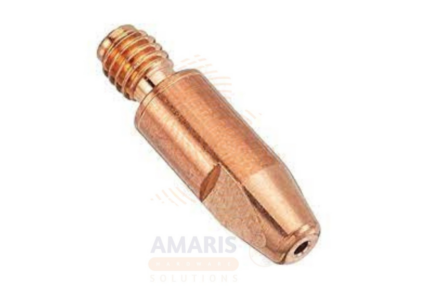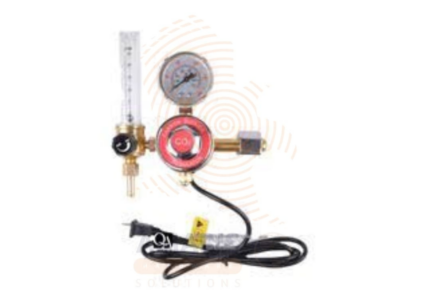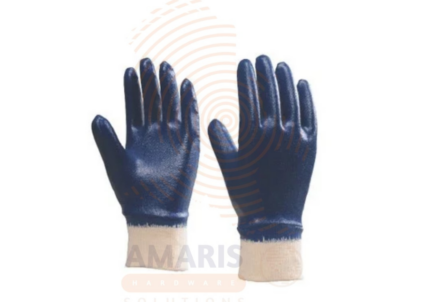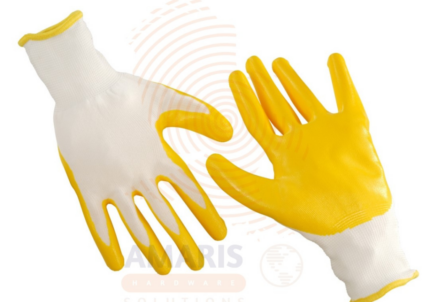Welding Gloves
WhatsApp Order
Welding gloves are specialized protective hand coverings designed to shield welders from the various hazards associated with welding processes. These gloves are typically made from heat-resistant materials such as leather or flame-resistant fabrics, providing insulation against the intense heat generated during welding. Additionally, welding gloves offer protection against sparks, molten metal, and UV radiation produced during welding operations. They play a crucial role in ensuring the safety of welders by minimizing the risk of burns, cuts, and other injuries to the hands and wrists while allowing for dexterity and control during the welding process.
Description
Uses of a Welding gloves
- Protection from Heat: Welding gloves are designed to withstand the intense heat generated during welding processes. They provide thermal insulation, preventing burns and discomfort caused by exposure to high temperatures.
- Shielding against Sparks and Splatter: Welding often produces sparks, molten metal, and other debris. Welding gloves act as a barrier, protecting the hands and wrists from these potentially harmful elements, reducing the risk of burns and injuries.
- Resistance to Radiation: Welding generates ultraviolet (UV) and infrared (IR) radiation. Specialized welding gloves are equipped with materials that offer protection against these types of radiation, safeguarding the skin from potential long-term damage.
- Abrasion and Cut Resistance: Welding gloves are typically made from durable materials, such as leather or flame-resistant fabrics, that provide resistance against abrasion and cuts. This protects the hands from sharp edges and rough surfaces encountered in welding and related tasks.
- Enhanced Grip and Dexterity: Despite their protective features, welding gloves are designed to maintain a balance between protection and dexterity. They allow welders to have a good grip on tools and materials, ensuring precision and control during welding operations.
- Insulation from Electric Shock: In certain welding applications, there is a risk of electric shock. Welding gloves, especially those designed for specific welding processes like arc welding, may offer insulation to protect against electric shock hazards.
- Comfort and Extended Wear: Welding gloves are constructed to provide comfort during prolonged use. This is crucial as welding tasks often require extended periods of hand protection, and comfortable gloves contribute to overall safety and productivity.
- Multi-Process Capabilities: Welding gloves are versatile and suitable for various welding processes, including MIG welding, TIG welding, stick welding, and more. They are designed to meet the specific requirements and hazards associated with each type of welding
SAFETY HANDLING PRECAUTIONS
- Proper Selection of Gloves: Choose welding gloves that are appropriate for the specific welding process being performed. Different processes may require gloves with varying levels of heat resistance, insulation, and protection against specific hazards.
- Inspect Gloves Regularly: Before each use, inspect welding gloves for any signs of damage, wear, or deterioration. Replace gloves that show excessive wear or damage to maintain their effectiveness in protecting against hazards.
- Proper Fit: Ensure that the welding gloves fit snugly on the hands without being too tight or too loose. Properly fitted gloves provide better dexterity and reduce the risk of accidents.
- Avoid Contact with Hazardous Substances: Welding gloves are primarily designed for protection during welding operations. Avoid using them for handling chemicals, sharp objects, or other substances that could compromise their integrity.
- Protect Against Electric Shock: If the welding process involves a risk of electric shock, use gloves specifically designed to provide electrical insulation. Additionally, ensure that other personal protective equipment (PPE), such as insulated footwear and clothing, is worn as needed.
- Use Additional PPE: While welding gloves are crucial, they are just one component of personal protective equipment. Depending on the welding process, wear additional PPE such as welding helmets with proper eye protection, flame-resistant clothing, and appropriate respiratory protection.
- Safe Handling of Hot Materials: Be cautious when handling hot workpieces, tools, or equipment. Allow sufficient cooling time before touching materials to avoid burns. Use pliers or other tools when handling hot objects whenever possible.
- Good Ventilation: Ensure that the work area is well-ventilated to reduce exposure to welding fumes. Proper ventilation helps in minimizing respiratory hazards associated with welding.
- Training and Education: Provide proper training to welders on the correct use and limitations of welding gloves. Educate them on potential hazards, emergency procedures, and the importance of adhering to safety protocols.
- Emergency Preparedness: Be aware of emergency procedures, including the location of fire extinguishers, first aid kits, and emergency exits. In the event of an accident, prompt and appropriate action can minimize the severity of injuries.
Related products
M8 Tips for MIG Welding Torch
M8 Tips for MIG Welding Torch, or Metal Inert Gas welding torch, is a handheld device used in the MIG welding process. It consists of a handle, trigger, and a nozzle through which a consumable electrode wire is fed. The torch is connected to a welding power source that generates an electric arc between the wire and the workpiece, melting the wire and creating a weld. The torch also incorporates a shielding gas, typically a mixture of inert gases, to protect the weld from atmospheric contamination. MIG welding torches are versatile tools widely used for their ease of operation and efficiency in joining various metals.
Nitrile Gloves
PRODUCT DESCRIPTION
Nitrile gloves are a type of disposable protective glove made from synthetic rubber known as nitrile. These gloves are popular in various industries, including healthcare, laboratory work, and food handling, due to their excellent durability, puncture resistance, and chemical resistance. Nitrile gloves offer an alternative to latex gloves for individuals with latex allergies. They are also known for their snug fit and tactile sensitivity, making them suitable for tasks that require precision and fine motor skills.
Regulator
An Regulator tool, short for oxygen regulator, is a specialized device designed to control and regulate the flow of oxygen from a supply source, such as a compressed gas cylinder, to a desired level for specific applications. Oxy-reg regulators are commonly used in various industries, including healthcare, welding, cutting, and other processes where precise control of oxygen flow is essential. These regulators ensure a safe and controlled delivery of oxygen, maintaining the required pressure levels for optimal performance in applications ranging from medical oxygen therapy to industrial welding operations.
Rubber Coated Gloves (Blue)
A Rubber Coated Gloves (Blue) refers to a type of protective hand wear that is constructed with a base material, commonly fabric or another flexible material, and has a layer of rubber applied or coated onto the surface of the gloves. The rubber coating serves various purposes, such as providing enhanced grip, protection against liquids, chemicals, or abrasions, and potentially increasing the overall durability of the gloves. The "blue" specification in this context likely refers to the color of the gloves, which may have been added for visibility or aesthetic reasons. These gloves are often used in industrial, medical, or other settings where hand protection and tactile sensitivity are important.
Rubber Coated Gloves (Yellow)
Rubber Coated Gloves (Yellow) are protective handwear designed for improved grip, durability, and safety in industrial, construction, gardening, and general handling tasks. These gloves feature a textured rubber coating—typically on the palm and fingers—over a flexible fabric liner, offering excellent resistance to abrasion, punctures, and light liquid exposure. Their yellow color enhances visibility, making them ideal for work environments where safety and control are critical.
Steel Wire Brush
A steel wire brush refers to a handheld tool used for various cleaning, deburring, and surface preparation tasks. It consists of a handle and six rows of steel wire bristles attached to the head. The purpose of the brush is to remove rust, paint, scale, or other debris from surfaces such as metal, wood, or concrete. The steel bristles are arranged in rows to provide effective coverage and enhance the brush's ability to scrub and clean. This type of brush is commonly employed in metalworking, welding, construction, and other industrial applications where abrasive cleaning is necessary.
Welding Helmet
A welding helmet is a protective headgear worn by welders to shield their eyes, face, and neck from sparks, intense light, ultraviolet and infrared radiation generated during welding processes. Typically equipped with a protective lens, often auto-darkening, the helmet allows the welder to see the workpiece clearly during the non-welding phases and automatically darkens to protect the eyes when the welding arc is initiated. It plays a crucial role in ensuring the safety and well-being of welders by preventing eye injuries and minimizing exposure to harmful radiation.
Welding Locking Pliers
Welding locking pliers, often referred to as welding clamps or welding grip pliers, are versatile hand tools designed for securely holding and clamping materials during welding or metalworking tasks. These pliers typically have a locking mechanism that allows them to firmly grip onto the workpiece, providing a stable and hands-free hold. The jaws of welding locking pliers are often serrated or textured to enhance grip on various materials, and they can be adjusted to accommodate different sizes of workpieces. This tool is widely used in welding and fabrication processes to hold pieces together, ensuring accurate and stable alignment during welding or other metalworking operations.


 Acrylic Sealants
Acrylic Sealants Construction Adhesives
Construction Adhesives Double-Sided Tape
Double-Sided Tape Duct Tape
Duct Tape Electrical Tape
Electrical Tape Epoxy & Resins
Epoxy & Resins Masking Tape
Masking Tape
 Automotive Wrenches & Socket Sets
Automotive Wrenches & Socket Sets Battery Chargers & Jump Starters
Battery Chargers & Jump Starters Car Jacks & Stands
Car Jacks & Stands Car Wash & Detailing Products
Car Wash & Detailing Products Diagnostic Tools
Diagnostic Tools Tire Inflators
Tire Inflators Vehicle Lighting
Vehicle Lighting Oil & Lubricants
Oil & Lubricants
 Adhesives & Sealants
Adhesives & Sealants Bricks & Blocks
Bricks & Blocks Cement & Concrete
Cement & Concrete Drywall & Plaster
Drywall & Plaster Flooring (Tiles, Wood, Laminate)
Flooring (Tiles, Wood, Laminate) Lumber & Plywood
Lumber & Plywood Paints, Primers & Coatings
Paints, Primers & Coatings Insulation Materials
Insulation Materials Roofing Materials
Roofing Materials
 Circuit Breakers
Circuit Breakers Electrical Cables & Wires
Electrical Cables & Wires Switches & Sockets
Switches & Sockets Fuses & Relays
Fuses & Relays Connectors & Terminals
Connectors & Terminals Electrical Boxes & Panels
Electrical Boxes & Panels Conduit & Fittings
Conduit & Fittings Lighting Fixtures & Bulbs
Lighting Fixtures & Bulbs Extension Cords & Power Strips
Extension Cords & Power Strips
 Anchors
Anchors Bolts
Bolts Clips & Clamps
Clips & Clamps Screws
Screws Nuts
Nuts Washers
Washers Rivets
Rivets Nails
Nails Threaded Rods
Threaded Rods
 Hammers
Hammers Measuring Tools (Tapes, Levels, Calipers)
Measuring Tools (Tapes, Levels, Calipers) Screwdrivers
Screwdrivers Pliers & Cutters
Pliers & Cutters Saws & Blades
Saws & Blades Chisels & Punches
Chisels & Punches Allen Keys & Hex Keys
Allen Keys & Hex Keys Ratchets & Socket Sets
Ratchets & Socket Sets Wrenches & Spanners
Wrenches & Spanners
 Power Tool Accessories (Blades, Bits, Discs)
Power Tool Accessories (Blades, Bits, Discs) Rotary Tools
Rotary Tools Saws (Circular, Jigsaw, Reciprocating)
Saws (Circular, Jigsaw, Reciprocating) Drills & Drivers
Drills & Drivers Grinders & Sanders
Grinders & Sanders Heat Guns
Heat Guns Nail Guns
Nail Guns Impact Wrenches
Impact Wrenches Batteries & Chargers
Batteries & Chargers
 Pipes & Fittings (PVC, Copper, PEX)
Pipes & Fittings (PVC, Copper, PEX) Plumbing Tools
Plumbing Tools Pumps & Motors
Pumps & Motors Sealants & Adhesives for Plumbing
Sealants & Adhesives for Plumbing Valves & Taps
Valves & Taps Water Heaters
Water Heaters Drainage Systems
Drainage Systems Faucets & Fixtures
Faucets & Fixtures Hoses & Tubing
Hoses & Tubing
 Hinges & Latches
Hinges & Latches Hooks & Brackets
Hooks & Brackets Window Hardware
Window Hardware Chains & Cables
Chains & Cables Casters & Wheels
Casters & Wheels Shelving & Storage Systems
Shelving & Storage Systems Door Handles & Locks
Door Handles & Locks Drawer Slides & Cabinet Hardware
Drawer Slides & Cabinet Hardware
 Personal Protective Equipment (PPE)
Personal Protective Equipment (PPE) Respirators & Masks
Respirators & Masks Safety Glasses
Safety Glasses Safes
Safes Security Cameras
Security Cameras Gloves
Gloves Helmets
Helmets Ear Protection
Ear Protection Fire Safety Equipment
Fire Safety Equipment Locks & Padlocks
Locks & Padlocks Motion Sensors & Alarms
Motion Sensors & Alarms
 Garden Fencing
Garden Fencing Garden Furniture Hardware
Garden Furniture Hardware Lawn Mowers
Lawn Mowers Trimmers & Edgers
Trimmers & Edgers Shovels & Spades
Shovels & Spades Rakes & Hoes
Rakes & Hoes Pruning Shears & Loppers
Pruning Shears & Loppers Watering Systems (Hoses, Sprinklers, Nozzles)
Watering Systems (Hoses, Sprinklers, Nozzles)
 Interior Paints
Interior Paints Paint Brushes & Rollers
Paint Brushes & Rollers Paint Strippers & Thinners
Paint Strippers & Thinners Paint Trays & Accessories
Paint Trays & Accessories Exterior Paints
Exterior Paints Spray Paints
Spray Paints Primers & Undercoats
Primers & Undercoats Varnishes & Stains
Varnishes & Stains
 Gaskets & Seals
Gaskets & Seals Hydraulic Fittings
Hydraulic Fittings Industrial Fasteners
Industrial Fasteners Industrial Hoses
Industrial Hoses Lubricants & Greases
Lubricants & Greases Metal Sheets & Bars
Metal Sheets & Bars Bearings & Bushings
Bearings & Bushings Belts & Pulleys
Belts & Pulleys
 HVAC Filters
HVAC Filters Insulation for HVAC
Insulation for HVAC Air Conditioners
Air Conditioners Refrigerants
Refrigerants Ventilation Ducts & Fittings
Ventilation Ducts & Fittings Thermostats & Controllers
Thermostats & Controllers Fans & Blowers
Fans & Blowers
 Pegboards & Hooks
Pegboards & Hooks Shelving Units
Shelving Units Storage Bins & Containers
Storage Bins & Containers Toolboxes & Tool Chests
Toolboxes & Tool Chests Workbenches
Workbenches Drawer Organizers
Drawer Organizers Labeling Supplies
Labeling Supplies
 Welding Accessories (Clamps, Brushes)
Welding Accessories (Clamps, Brushes) Welding Electrodes & Rods
Welding Electrodes & Rods Welding Helmets & Gloves
Welding Helmets & Gloves Welding Machines
Welding Machines Soldering Irons & Stations
Soldering Irons & Stations Flux & Solder Wire
Flux & Solder Wire
 Generator Accessories
Generator Accessories Inverters
Inverters Portable Generators
Portable Generators Power Inverters
Power Inverters Transfer Switches
Transfer Switches Diesel & Gasoline Generators
Diesel & Gasoline Generators
 Transport Equipment: Carts, Dollies, and Hand Trucks
Transport Equipment: Carts, Dollies, and Hand Trucks Storage Solutions: Pallets, Racks, and Containers
Storage Solutions: Pallets, Racks, and Containers Lifting Equipment: Hoists, Cranes, and Jacks
Lifting Equipment: Hoists, Cranes, and Jacks Conveyors and Accessories: Belts and Rollers
Conveyors and Accessories: Belts and Rollers








